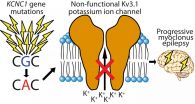The National Institute of Allergy and infectious Diseases, of the National Institutes of Health, funded the project that was coordinated by Michael Katze and Xinxia Peng at the University of Washington in Seattle and Federica Di Palma and Jessica Alfoldi at the Broad Institute of MIT and Harvard.
"The sequencing of the ferret genome is a big deal," said Michael Katze, UW professor of microbiology who led the research effort. "Every time you sequence a genome, it allows you to answer a wide range of questions you couldn't before. Having the genome changes a field forever."
Ferrets have long been considered the best animal model for studying a number of human diseases, particularly influenza, because the strains that infect humans also infect ferrets. These infections spread from ferret to ferret much as they do from human to human.
In the study, scientists at Broad Institute of MIT and Harvard, led by Federica Di Palma and Jessica Alfoldi, first sequenced and annotated the genome of a domestic sable ferret, Mustela putorius furo. They then collaborated with the Katze group on the subsequent analysis. A technique called transcriptome analysis. This technique identifies all the RNA that is being produced, or transcribed, from areas of the genome that are being activated at a given point in time. This makes it possible to see how the ferret cells are responding when challenged by influenza and in cystic fibrosis.
"By creating a high quality genome and transcriptome resource for the ferret, we have demonstrated how studies in non-conventional model organisms can facilitate essential bioscience research underpinning health," said Federica Di Palma, director of science in Vertebrate & Health Genomics at TGAC, The Genome Analysis Centre.
In the influenza portion of the study, Yoshihiro Kawaoka's group at the University of Wisconsin-Madison exposed ferrets to a reconstructed version of the virus that caused the deadly pandemic flu of 1918, the so-called Spanish flu, which killed 25 million people worldwide, and the swine-flu virus that caused the worldwide pandemic of 2009-2010 and continues to cause disease today.
They then collected samples from the animals' tracheas (windpipes at the base of the throat) and lungs on the first, third and eighth day of the infection for transcriptome analysis.
The Katze team found that two viruses affected the ferret trachea and the lungs differently. The 1918 virus, for example, triggered a marked transcriptional response in the trachea on the first day of infection, a response that was sustained though day 8.
The 2009 strain, on the other hand, triggered a response that started slowly and grew gradually, peaking on day 8.
"The 1918 flu elicited a huge response on day one and that response was sustained," says Xinxia Peng, a research assistant professor in the Katze lab and a specialist in computational biology who was lead author on the study. "The 2009 pandemic flu triggered a response that gradually grew over several days. They had very different trajectories."
In the lung, however, gene transcription triggered by both viruses was roughly the same, but was different from that seen in the trachea. "This side by side comparison reveals that the host response to these two viruses differs primarily in the trachea and may explain the course of infection," Peng said.
To better understand cystic fibrosis, John Engelhardt's group at the University of Iowa genetically engineered a ferret lacking the gene for a membrane protein called the cystic fibrosis transmembrane conductance regulator (CFTR). Defects in the CFTR gene are responsible for this inherited disease, which affects 30,000 Americans. Such gene knockout models are a common way to study how loss of a gene or the inheritance of a defective gene affects cell function.
In the cystic fibrosis model, analysis of the transcriptome of the gene knock-out ferrets revealed that changes in the expression of genes can be seen on the first day of life and increase significantly over the next 15 days.
"We found that there are transcriptional changes from day one, right out-of-the-gate, and many of the changes are very similar to those seen in humans," says Peng. "The findings suggest that some of the disease processes responsible for the lung damage seen in cystic fibrosis begin very early in life."
Katze said transcriptome responses seen in both the influenza studies and the cystic fibrosis studies closely resemble those seen in humans. The findings suggest that ferret models will not only help scientists understand these two diseases, but also a broader set of diseases including heart disorders and diabetes.
INFORMATION:
The project was conducted by researchers from the at the University of Washington; the Broad Institute of MIT and Harvard, Cambridge, Mass,; the European Bioinformatics Institute, Hinxton, Cambridge, UK; the Department of Pathobiological Sciences, School of Veterinary Medicine, University of Wisconsin, Madison, Wisc,; Department of Anatomy and Cell Biology, Carver College of Medicine, University of Iowa, Iowa City, Iowa; the Molecular and Cellular Biology Program, Carver College of Medicine, University of Iowa, Iowa City, Iowa; the Department of Computer Science, Swiss Federal Institute of Technology and the Swiss Institute of Bioinformatics, Zurich, Switzerland; the Wellcome Trust Sanger Institute, Wellcome Trust Genome Campus, Hinxton, Cambridge, UK; the Centers for Disease Control and Prevention, Atlanta, Ga.; Department of Biological Statistics and Computational Biology, Cornell University, Ithaca, N.Yp.; the Department of Wildlife Ecology and Conservation, University of Florida, Gainesville, Fla., the Department of Genetics, Evolution and Environment, University College London and the Department of Computer Science, University College London, London, UK; ERATO Infection-Induced Host Responses Project, Japan Science and Technology Agency, Saitama, Japan, the Division of Virology, Department of Microbiology and Immunology, Institute of Medical Science, University of Tokyo and the Department of Special Pathogens, International Research Center for Infectious Diseases, Institute of Medical Science, University of Tokyo, Minato-ku, Tokyo, Japan, the Laboratory of Bioresponses Regulation, Department of Biological Responses, Institute for Virus Research, Kyoto University, Kyoto, Japan; the Department of Medical Biochemistry and Microbiology, Uppsala University, Uppsala, Sweden; Center for Gene Therapy, Carver College of Medicine, University of Iowa, Iowa City, Iowa; the Washington National Primate Research Center, Seattle, Wash.; Biogen Idec, Cambridge, Mass.,; the Division of Biology, California Institute of Technology, Pasadena, Calif,,; and Vertebrate and Health Genomics, The Genome Analysis Center, Norwich, UK.
Funding support came from: the National Institute of Allergy and Infectious Diseases, National Institutes of Health, Department of Health and Human Services, under contracts. HHSN272200800060C and HHSN272201400005C and Public Health Service Grant P51OD010425. For the Broad Institute of MIT and Harvard, this project was funded in whole or in part with federal funds from the National Institute of Allergy and Infectious Diseases, National Institutes of Health, Department of Health and Human Services, under contract HHSN272200900018C, and training grants 9T32OD010423-06 and 5T32RR023916-05 from the NIH Office of the Director. Support for worked conducted at the University of Iowa came from the NIH National Institute of Diabetes and Digestive and Kidney Diseases grants R37 DK047967, R24 DK096518 and P30 DK054759, and National Heart, Lung, and Blood Institute grant R01 HL108902. Support for individual researchers came from SNSF advanced researcher fellowship (#136461) and the NIH National Institute of General Medical Sciences R01 GM102192. Wellcome Trust Sanger Institute is operated by Genome Research Limited, a charity registered in England with number 1021457 and a company registered in England with number 2742969.




